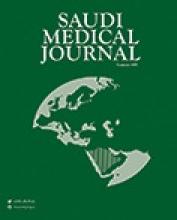Abstract
OBJECTIVES: Detection of the residual bone marrow (BM) involvement is essential in treatment of patients with non-Hodgkin's lymphoma (NHL). Bilateral iliac crest BM biopsies appear to have low sensitivity for BM infiltration, while magnetic resonance imaging (MRI) presents more global view of BM. This study was conducted to determine the advantage of femoral marrow MRI as a non-invasive technique over bilateral iliac crest BM biopsies in detecting BM infiltration before treatment and residual disease after completion of treatment.
METHODS: Over a period of 27 months from January 2002 to March 2004, a total of 30 patients with newly diagnosed NHL were included in the study. Magnetic resonance imaging of 26 patients were conducted in King Fahd Hospital of the University, Al-Khobar, Kingdom of Saudi Arabia. Magnetic resonance imaging of 4 patients were referred from different hospitals in the Eastern Province. Twenty-five patients were of B-cell type and 5 patients were of T-cell type. Coronal MRI of the pelvis and femoral marrow were obtained by the T1, T2-weighted spin echo sequences and short TI inversion recovery technique.
RESULTS: Magnetic resonance images showed BM infiltration in 17 cases (56.7%) before treatment and positive biopsy results were found in 9 cases (30%); all had abnormal MR images. There was a significant difference between both methods in the detection of infiltration (p=0.037). Magnetic resonance imaging showed that 58.8% of cases have scattered pattern, 23.5% were uniform and 17.6% of cases have nodular patterns. Magnetic resonance images after completion of treatment showed residual BM infiltration in 6 out of 17 cases who previously had positive MR images and only one case of them had a positive BM biopsy with a significant difference between both methods and all of them relapsed within 6 months (p=0.034).
CONCLUSIONS: Magnetic resonance images of the pelvis and femoral marrow were superior than BM biopsy on detection of BM infiltration before treatment and residual infiltration after treatment.
- Copyright: © Saudi Medical Journal
This is an open-access article distributed under the terms of the Creative Commons Attribution-Noncommercial-Share Alike 3.0 Unported, which permits unrestricted use, distribution, and reproduction in any medium, provided the original work is properly cited.






